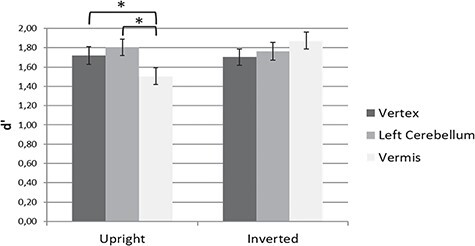Figure 3 .

Mean d′ rates as a function of TMS site (vertex, left cerebellum and vermis) and Orientation (upright vs. inverted) in Experiment 2 (collapsed across timing of single-pulse TMS: at stimulus onset vs. 100 ms from onset). In the upright orientation, single-pulse TMS over the vermis affected participant’s ability to discriminate biological from scrambled motion compared to TMS over the left cerebellum and over the vertex. TMS had no effect on discrimination of biological motion when animations were presented upside-down. Error bars represent ±1 SEM. Asterisks denote a significant difference between TMS conditions.
